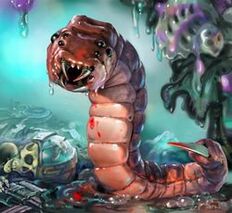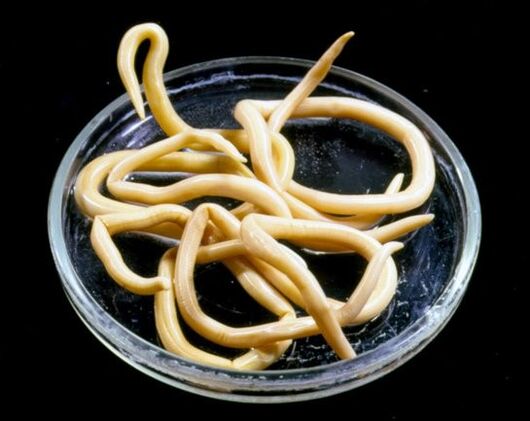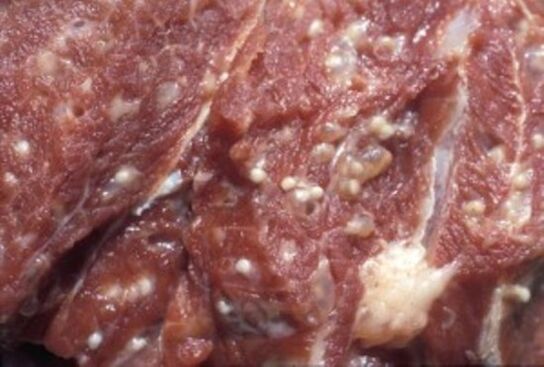
Throughout life, a person is at risk of being infected with many different types of parasites. The most common are helminths (worms in humans). These parasites in the human body lead to many complications, among which are: gastrointestinal disorders, physical damage to internal organs and helminthiasis. Helminth disease is not one disease but a group of diseases caused by parasites living inside humans. All helminths are divided into 3 main types:
- nematodes (belonging to the order nematodes), prominent representatives - roundworms, pinworms, roundworms;
- tapeworms, or cestodes (an order of flatworms), represented by tapeworms, beef tapeworms;
- Trematodes, or trematodes (type of flatworm), are represented by liver flukes.
Because helminths leave the host's body during the reproductive period to preserve the species, transmit to another host or into the environment, they are also divided according to the mode of transmission:
- Mechanical transfer involves movement over long distances, while no deep growth occurs in the body of the carrier. They include most arthropods (crustaceans, spiders and millipedes), often carried on the legs of ordinary flies.
- An intermediate host is a specific mode of transmission in which one of the developmental stages occurs within the body of the vector. For example, for beef tapeworms, the carrier (intermediate host) is livestock and humans are the ultimate carriers.
Helminths also differ in mode of transmission:
- activity (contact);
- passive (food).
Contact helminths have the ability to enter the human body through mucous membranes and skin (schistosomiasis, hookworm). Foodborne illnesses are more common; they develop in humans after eating unwashed food, when coming into contact with sick people or not observing the rules of personal hygiene.
In total, there are more than 250 species of lower worms that parasitize humans in the world. Since the symptoms of the presence of worms in humans have different manifestations, when in doubt, you should contact a specialist and get tested.
The life cycle of worms, their reproduction and development
An example of the development of helminths is the classic diagram of the life cycle of a roundworm. Parasite eggs are extremely resistant to adverse external influences and can survive in the ground for up to six months. The development of the larvae itself takes from 2 weeks to 2 months, depending on environmental conditions: temperature, humidity, oxygen availability. Cooked eggs along with food enter the stomach, where gastric juice erodes the egg shell, releasing larvae.

The roundworm then enters the blood through the intestinal wall and begins to move throughout the entire vascular system until it enters the pulmonary alveoli. The nematode larva is aerobic, only here it becomes active and continues to develop. Feeding on blood, it grows 3-4 mm in length. Reaching primary maturity 4-5 days after invasion, the roundworm begins to move towards the bronchi. Its movement causes coughing in humans, as a result of which the larvae along with mucus enter the oral cavity and again into the intestines. Here the final stage of the formation of larvae into adults occurs.
The life cycle of an adult roundworm lasts about a year, during which time it lays up to 250, 000 eggs. Human health, and sometimes even life, directly depends on the presence of worms in the body and their quantity, which is why it is important to start treatment as soon as possible. the better. Ascariasis is accompanied by poisoning and complications include intestinal obstruction, which in some cases requires emergency surgical intervention.
Reproduction of helminths occurs in 2 ways, on the basis of which worms are divided into helminths and helminths. Normally, parasite eggs will exist in the outside environment, where they mature. The egg must then enter the host, where it either develops fully (geological helminth) or undergoes transformation into a larva (biological fluke).

For biological helminths, the development process is more complex, the stages of development into adult and adult worms are separated from the stage of appearance of the larvae. That is, from the external environment, the eggs first enter the intermediate carrier, where the larvae hatch. It then needs to be ingested by the final host to reach its adult form. Sometimes biological worms change up to four intermediate carriers before reaching the final host.
Symptom
How to determine the presence of worms? Polymorphic and painless symptoms in the early stages of the disease further complicate diagnosis. Usually the cause of the appearance of worms in humans is associated with the consumption of old or contaminated food, and the parasites themselves live directly in the digestive tract, so signs of their presence in the bodyThe human body in most cases is involved in the functioning of the digestive system. intestine:
- loose (unstable) stools;
- pain and bloating;
- allergic skin rash;
- bloating;
- nausea;
- vomiting;
- lack or excess appetite;
- at night - sleep disorders, restlessness, teeth grinding, drooling;
- itching in the anus;
- presence of mucus or blood in the stool.
These symptoms appear after infection and last for a short time (about 7 days). In case of reinfection, they are repeated after 2-3 weeks. In the absence of treatment or due to the appearance of an acute or chronic form of the disease, some symptoms do not disappear, and the consequences of the parasite's long existence in the body add to them:
- Intoxication appears almost simultaneously with infection, but in the early stages it is not so noticeable. The greater the number of worms in the human body, the stronger the symptoms of poisoning - from morning sickness to vomiting and abdominal pain.
- Lung obstruction (infiltration), bronchospasm, pneumonia. The main culprits are parasites that develop in the alveoli of the lungs and damage them, causing an inflammatory process.
- Inflammation of the heart muscle (myocarditis). An infectious disease, resulting from the vital activity of helminths and subsequent intoxication.
- Meningitis is a dangerous inflammation of the brain and meninges caused by bacteria and protozoa.
Different pathogens have their own manifestations and consequences, but most symptoms are common to all types of helminths.
Diagnose
Diagnosis is carried out in laboratory conditions. Only in this case, when there are helminth eggs and their signs in the blood or feces, can helminthiasis be diagnosed with certainty. However, fecal analysis is not always enough - some types of parasites do not manifest themselves in it. A special method to determine the presence of worms is a serological test for antibodies in the blood. To diagnose helminthiasis, the following are used:
- research on bile;
- Macroscopic examination (to identify roundworms and pinworms);
- muscle tissue biopsy to test for trichinosis;
- X-ray and ultrasound.
Trichinosis is a parasitic disease in which pathogen larvae spread throughout the host's body, causing massive damage to organs and the central nervous system, after which they settle in muscle tissue. Parasites in human muscles gradually create an infiltrate around them and symptoms of their presence in the body subside, but by this time the host's health is already compromised. serious harm.

One of the main symptoms can be considered eosinophilia, in which the number of eosinophils in the patient's blood increases sharply. Eosinophils are a subtype of white blood cells that react to the presence of even the smallest foreign bodies in the circulatory system. In places where parasitic larvae accumulate, internal swellings and spots on the skin quickly appear - traces of penetration. They also exist in sputum and lung fluid.
Since the symptoms of helminthiasis are very diverse and largely overlap with signs of other diseases, self-diagnosis cannot be completely reliable. There are cases where after eating bananas, people noticed black fibers in the stool and mistakenly thought they were worms. Before starting treatment, it is necessary to undergo all tests to determine the presence and type of parasites.
Treatment of helminths
When treating parasitic diseases, some general rules should be followed:
- Thoroughly disinfect the patient's linens and the room where the patient is located. Reduce contact to a minimum, separate dishes.
- The strict diet does not include alcohol. It is recommended to drink carrot juice and infusion of birch buds.
- Maintain personal hygiene, wash hands and laundry regularly, and clean the place.
- Monitor treatment progress and its effectiveness.
Modern treatment methods exclude the use of a separate drug, as this does not guarantee complete coverage of all types of helminths. Usually, the doctor prescribes a drug whose initial effect weakens the parasite. After 3 days, depending on the patient's age and the severity of the infection, anthelmintics are prescribed. Pregnant women or people with contraindications to taking the drug are prescribed a non-toxic drug of the tetrahydropyrimidine group.
If it is not possible to see a doctor, then use folk remedies. The following are good dewormers:
- Garlic infusion enema, take garlic on an empty stomach;
- tansy infusion on an empty stomach 4 times a day before meals;
- tincture of wormwood in wine, take 3 times a day, 20 mg.
Today, helminth infections are diagnosed and treated in a short time. If you do not ignore the disease and start treatment in time, this will help avoid complications and relapses. Parasitic diseases pose the greatest danger to children: mental retardation, complications arising in the form of chronic diseases and inflammatory processes. It is extremely important to promptly explain to your child the need to wash his hands and follow the rules of personal hygiene. Adults are also asked to follow other precautions.
Preventing helminths
In addition to personal hygiene, there are several factors that influence the elimination of the cause of worms:
- Wash vegetables and fruits with hot water;
- Keep the house clean, wet mop regularly;
- A balanced diet provides the body with a sufficient amount of vitamins of all groups;
- monitor the condition of pets, visit the veterinarian annually;
- Proper heat treatment of fish and meat;
- prevent insects living in the house;
- Avoid swimming and resting in livestock grazing areas.
Compliance with preventive measures and timely consultation with a doctor in case of infection will help avoid complications. Using the correct dosage of medication as prescribed by a medical professional will quickly eliminate parasites. You can use folk remedies in combination with prescribed medications.






































